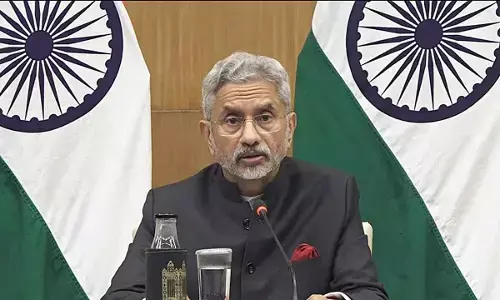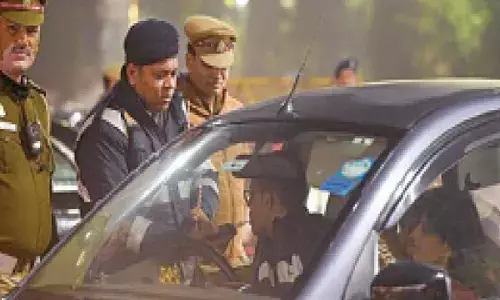Speedy implementation of RoW rules key to rural internet connectivity

Speedy implementation of RoW rules key to rural internet connectivity
Although a majority of States and UTs have broadly aligned their RoW policy with that of GoI, there are some which are yet to do so
A picture of a father holding an umbrella for his daughter, while she attends an online class amid heavy rains far away from home in a remote Dakshina Kannada village has gone viral in social media. A pet dog on guard duty, while the children trek arduously in a forest near Trissur to attend online classes at a spot on top of a rock, the only place receiving mobile network, has also been reported in news.
Online classes are likely to continue in the Covid-19 era and internet has become a basic necessity. However, some students are unable to attend online classes in remote areas due to no internet coverage or have to venture miles away from home in search of internet signal to attend online classes. In Karnataka itself, there are 471 uncovered villages out of 27,500 census villages.
Moreover, in the current era of phone wallets and digitization, internet is crucial for carrying out online transactions. A reliable internet connection is required for employees who are working remotely from their native places. Therefore, there is a pressing need for the Telecom Service providers (TSPs)/ Internet service Providers (ISPs) to ensure internet connectivity even in the rural areas.
To implement the vision of availability of digital infrastructure to everybody, Government of India (GoI), through Department of Telecommunications (DoT), has issued the Indian Telegraph Right of Way (RoW) rules in 2016 for laying of Optical Fibre (OF) as well as tower installation to be adopted by all State Governments and Union Territories (UTs). These rules have defined provisions for several enabling features like no restriction on location of telecom towers, single window clearance mechanism, defined time period for approvals, nominal administration fee and deemed approvals etc.
Although majority of States and UTs have broadly aligned their RoW policy with that of GoI, there are some which are yet to do so. Broadband Readiness Index (BRI) is the measurement of availability of digital communications infrastructure and conductive policy ecosystem within a State/UT. In whichever state RoW policy is not in tune with GoI RoW policy, there is an impediment to digital infrastructure expansion, especially in rural areas, contributing to a poor BRI.
For example, Karnataka Tower policy 2019 does not have most of the provisions as mentioned in the RoW rules notified by GoI in 2016. Application for setting up of towers range from Rs 15,000 to Rs 1,00,000 per tower in Karnataka's RoW policy instead of Rs 10,000 per application as per GoI RoW policy. There is no provision of deemed grant of permission. Restrictions have been imposed on installation of towers near schools, and heritage/religious structures. DoT has asked Karnataka government to align their policy with that of the GoI. TAIPA (Tower and Infrastructure Providers Association) had filed the case in court, following which the Karnataka Government had withdrawn its policy and drafted a new policy which falls in line with that of GoI, and issued it for obtaining the views of stakeholders. As of now there is no policy for laying of optical fibre cable in Karnataka. The new policy will encourage the TSPs to install towers and lay optical fibre cables in rural areas. It is anticipated that all the State Governments/UTs will align their RoW policy with that of GoI so that telecom network expansion can take place without any hindrance.
Apart from higher capital cost of providing telecom services in rural and remote areas, there will be low revenue in these areas. DoT has set up Universal Service Obligation Fund (USOF) in 2002 for compensating the TSPs for taking up unviable/un-remunerative telecom projects in rural/remote areas. USO provides subsidy for capital expenditure as well as for the maintenance. Every TSP contributes to this fund through Universal Service Levy of 5 per cent on their Adjusted Gross Revenue (AGR). This fund is deposited in the consolidated fund of India and is disbursed with the approval of parliament. It is a non-lapsable fund i.e., unspent amount under a targeted financial year will accrue for next year.
The provisions of USOF should be made attractive so that the TSPs will feel that it is a Universal Service 'Opportunity' Fund and not a Universal Service 'Obligation' Fund. Then many TSPs/Internet Service Providers (ISPs) will come forward to set up telecom/internet facilities in uncovered villages and there will be good response for the USOF tenders.
Under Digital India program launched in 2015, USOF is funding projects for: (1) provision of broadband connectivity in gram Panchayats (Bharat Net project), (2) provision of mobile connectivity in uncovered villages, and (3) provision of broadband services to citizens and institutions in rural areas.
Under National Broadband Mission (NBM), GoI envisages providing broadband access to all villages in the country by 2022. This mission is likely to see an investment of seven lakh crore with 90 per cent of the contribution coming from industry players and 10 per cent from USOF. This is an extension of Bharat Net project which envisages provision of broadband connectivity to all Gram Panchyats.
This mission also envisages connectivity through satellite medium (Satellite Broadband service) for the far flung areas where other type of connectivity (OF and Mobile) is not technically feasible. Among the TSPs, only BSNL is having experience in satellite communications field. Going forward, BSNL can utilize this unique experience and take initiative in the provision of satellite broadband service in those uncovered villages where other types of medium is not feasible.
Another unique service from BSNL is the provision of broadband facility in rural areas (where cable pairs /OF network is not available) through Bharat Air Fibre service which is a wireless connectivity using unlicensed spectrum. In this service, line of sight radio waves are used to reach villages up to 5 Km from exchange. Internet speed in this service will be up to 10 Mbps. This service is part of BSNL's effort to provide internet to 2.5 lakhs Gram Panchayats.
Way forward
1. State Governments/ UTs should align their RoW policies for towers and underground OF cables with that of GoI.
2. There must be a provision for erection of towers/masts on the top of Centre/State/other government buildings in these villages and sharing of infrastructure by all operators should be encouraged by DoT so that unnecessary duplication of infrastructure can be avoided.
3. More attractive features should be included in USOF so that TSPs/ISPs are encouraged to expand their internet coverage to rural/remote areas.
4. As online classes and remote working will continue, and digital banking transactions are the order of the day, rural telecom/broadband projects will also become remunerative in the near future.
5. Satellite broadband service should be deployed where other type of connectivity is not feasible.
With the above measures it is envisaged that entire India will be empowered by broadband. As per PM Modi's announcement on the last Independence Day, six lakh villages will be provided with OF connectivity within 1000 days. Even the remote Lakshadweep islands will be connected with Ernakulam with submarine OF cable. As we review the progress in the upcoming Independence Day, let's hope that substantial progress is made and we are on track to meet the target as promised.
(The author is a former Advisor, Department of Telecommunications (DOT), Government of India)

















